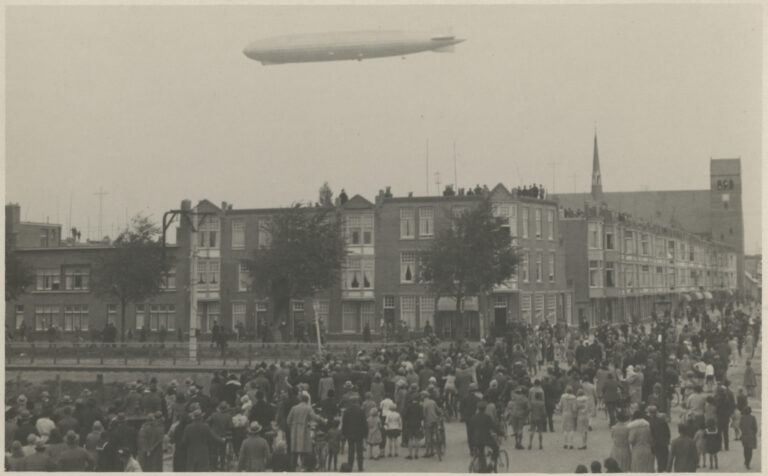When I was a child, my sisters and I would sing a little song about a zeppelin. This song can be treated as a game, as it comes with gestures. With every repetition you replace one more word with a gesture. If you make a mistake you are out of the competition.
Here is the song (with gestures), in a singable and therefore rather free translation:
We sailed up with a sigh (act like you sigh)
High up there in the sky (point into the air)
We were sitting very comfy in the gondola (fold your arms and rock them from side to side as if you are calming a baby)
No one could see us then (binoculars gesture in front of your eyes or cover your eyes)
We just had fun for ten (hold up all ten fingers)
Long live the zeppeli-i-in
You can find the Dutch version with the gestures on YouTube.
Departure from Friedrichshafen
This editor’s special adventure begins on Saturday 12 October 1929 in Friedrichshafen on Lake Constance. It was there, in 1899, that Ferdinand Graf von Zeppelin, the designer of the zeppelin, had a floating assembly hall built, from which his first airship was launched in 1900. The airship on which the reporter makes the trip is also called the ‘Graf Zeppelin’.
The journey has already been postponed once and he and his fellow passengers are waiting, a bit nervously in the hall of the Kurgartenhotel when finally the call comes: “Bitte… Meine Damen und Herr’n, einsteigen für die Zeppelinfahrt”.
The sailing time is a little after 11 p.m., so there is little to see. All the more striking is the sight of the first large city the zeppelin passes over: “Like a fairy tale from One Thousand and One Nights, the city opens before us, a wonderful starflower of countless shining lights.”
Over The Netherlands
After a few hours’ sleep, our reporter wakes up at sunrise, just as the ‘Graf Zeppelin’ is sailing over Delfzijl. Soon the tower of the Martini Church in Groningen comes into view and the airship flies twice around it. Then the zeppelin passes over “green, lush meadows with rich, proud farms.”
As the morning progresses, there are more and more waving spectators – although fewer in the smaller towns, because on Sunday mornings going to church is more important than watching a zeppelin.
In Zwolle people get a particularly good view, as the airship, sailing at 300 metres, descends to 150 metres above Het Loo Palace. There, Prince Hendrik, the husband of Queen Wilhelmina, and his brother Adolf admire the enormous aircraft. Whether Queen Wilhelmina and Princess Juliana watched from their rooms is something the newspapers cannot agree on.
The reporter sees little of the rest of the Veluwe, as a haze blocks the view from the zeppelin. For the same reason residents of the Brabant cities of Den Bosch, Tilburg and Breda can only catch a glimpse. But fortunately, the weather clears up and, accompanied by K.L.M. aircraft, the Zeppelin heads for the big cities. The escort planes are small Panders, from the furniture and aircraft factory with the same name in The Hague.
Over Rotterdam
The reporter sees that immense crowds have gathered in Rotterdam. “A mighty invisible hand has stopped all traffic in an instant. Not a tram moves, not a car moves, …. Everywhere the hundreds stand still and look upwards without moving”. “We have enjoyed the brave, industrious Rotterdammers down there perhaps even more than they have enjoyed us.”
Zeppelin over Den Haag
Via Delft and Rijswijk, they now head for The Hague: “The Laan van Meerdervoort, Duinoord in the distance, then the dunes packed with people and then: the vast blue sea that breaks against the yellow sand in slanting white lines”. The reporter would like to fly over his home town again, but time is running out and the captain of the ‘Graf Zeppelin’ maintains his northward course.
Meanwhile in The Hague
At 10 a.m., the city centre is just as busy as it is every Prinsjesdag. The terraces on the Buitenhof are bursting at the seams and the waiters serving drinks demand payment on delivery, because they are afraid that their guests will start running when the zeppelin comes into view.
Shortly before 11 a.m., the ‘Graf Zeppelin’ glides majestically above The Hague towards Scheveningen. At the stroke of 11, the enormous silver “air elephant” (as the reporter describes it), escorted by the aeroplanes, will pass over the Peace Palace, which suddenly seems small in comparison. A beautiful sight, a pity it ends so quickly. Over Zorgvliet, the airship disappears in the direction of the Kurhaus.
Dunes and beach
The dunes of The Hague are a splendid place from which to admire the spectacle of the zeppelin flying overhead. At the end of the Kwartellaan, whole families, young and old, are waiting, many armed with binoculars. They have climbed over the barbed wire and everyone holds their breath when two policemen come cycling down the Kwartellaan. Climbing the wire is normally forbidden, but the police understand that these are abnormal circumstances. They look up….. and ride on.
After continuing over Amsterdam, Utrecht and Nijmegen, among other places, the ‘Graf Zeppelin’ will return to Germany and land safely in Friedrichshafen on Sunday evening at ten to seven.
I tell you about important and exciting events in The Hague on my city walks and cycle tours.









